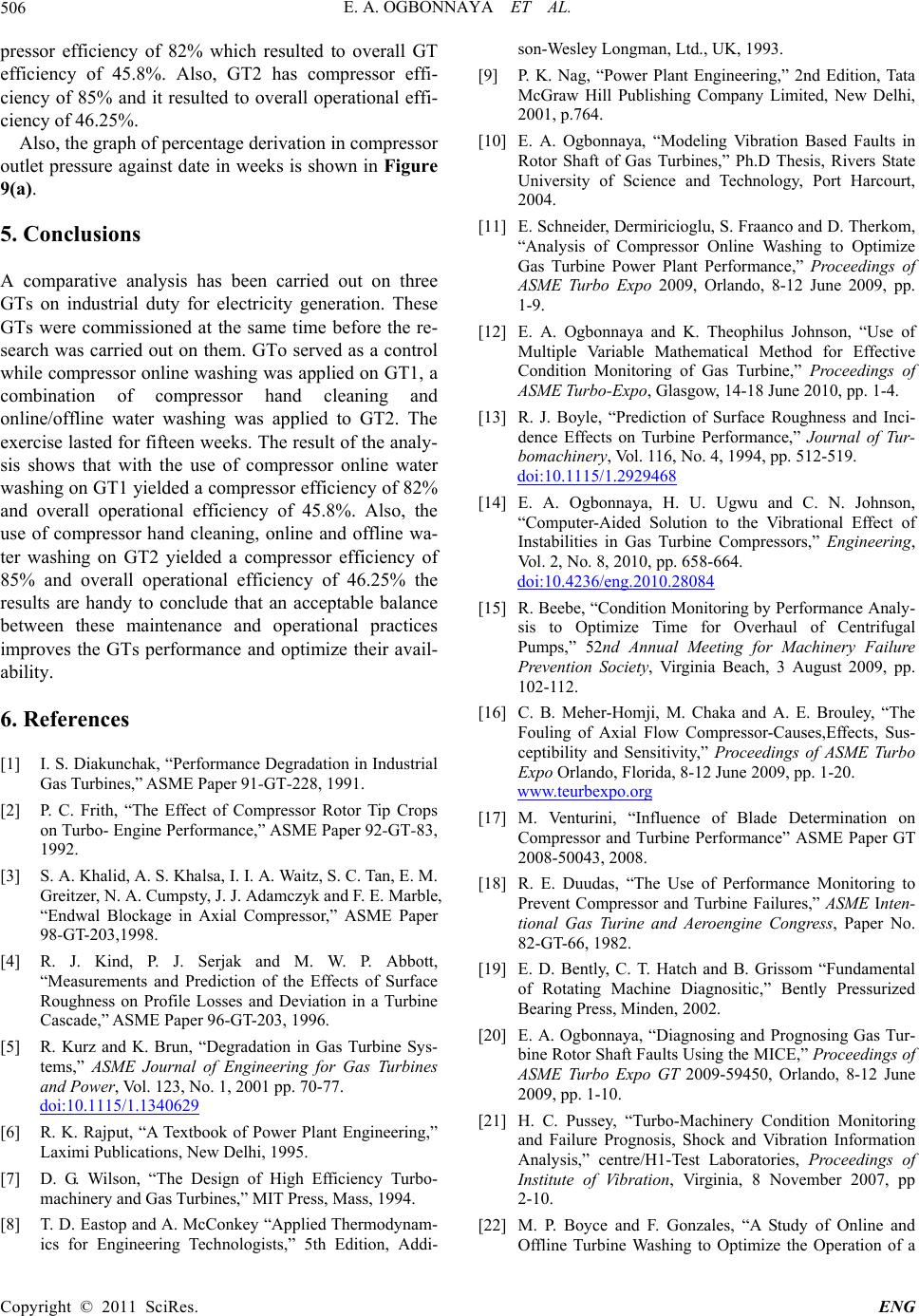
E. A. OGBONNAYA ET AL.
Copyright © 2011 SciRes. ENG
506
pressor efficiency of 82% which resulted to overall GT
efficiency of 45.8%. Also, GT2 has compressor effi-
ciency of 85% and it resulted to overall operational effi-
ciency of 46.25%.
Also, the graph of percentage derivation in compressor
outlet pressure against date in weeks is shown in Figure
9(a).
5. Conclusions
A comparative analysis has been carried out on three
GTs on industrial duty for electricity generation. These
GTs were commissioned at the same time before the re-
search was carried out on them. GTo served as a control
while compressor online washing was applied on GT1, a
combination of compressor hand cleaning and
online/offline water washing was applied to GT2. The
exercise lasted for fifteen weeks. The result of the analy-
sis shows that with the use of compressor online water
washing on GT1 yielded a compressor efficiency of 82%
and overall operational efficiency of 45.8%. Also, the
use of compressor hand cleaning, online and offline wa-
ter washing on GT2 yielded a compressor efficiency of
85% and overall operational efficiency of 46.25% the
results are handy to conclude that an acceptable balance
between these maintenance and operational practices
improves the GTs performance and optimize their avail-
ability.
6. References
[1] I. S. Diakunchak, “Performance Degradation in Industrial
Gas T urbines,” ASME Paper 91-GT-228, 1991.
[2] P. C. Frith, “The Effect of Compressor Rotor Tip Crops
on Turbo- Engine Performance,” ASME Paper 92-GT-83,
1992.
[3] S. A. Khalid, A. S. Khal sa, I. I. A. Waitz, S. C. Tan, E. M.
Greitzer, N. A. Cumpsty, J. J. Adamczyk and F. E. Marble,
“Endwal Blockage in Axial Compressor,” ASME Paper
98-GT-203,1998.
[4] R. J. Kind, P. J. Serjak and M. W. P. Abbott,
“Measurements and Prediction of the Effects of Surface
Roughness on Profile Losses and Deviation in a Turbine
Cascade,” ASME Paper 96-GT-203, 1996.
[5] R. Kurz and K. Brun, “Degradation in Gas Turbine Sys-
tems,” ASME Journal of Engineering for Gas Turbines
and Power, Vol. 123, No. 1, 2001 pp. 70-77.
doi:10.1115/1.1340629
[6] R. K. Rajput, “A Textbook of Power Plant Engineering,”
Laximi Publications, New Delhi, 1995.
[7] D. G. Wilson, “The Design of High Efficiency Turbo-
machinery and Gas Turbines,” MIT Press, Mass, 1994.
[8] T. D. Eastop and A. McConkey “Applied Thermodynam-
ics for Engineering Technologists,” 5th Edition, Addi-
son-Wesley Longman, Ltd., UK, 1993.
[9] P. K. Nag, “Power Plant Engineering,” 2nd Edition, Tata
McGraw Hill Publishing Company Limited, New Delhi,
2001, p.764.
[10] E. A. Ogbonnaya, “Modeling Vibration Based Faults in
Rotor Shaft of Gas Turbines,” Ph.D Thesis, Rivers State
University of Science and Technology, Port Harcourt,
2004.
[11] E. Schneider, Dermiricioglu, S. Fraanco and D. Therkom,
“Analysis of Compressor Online Washing to Optimize
Gas Turbine Power Plant Performance,” Proceedings of
ASME Turbo Expo 2009, Orlando, 8-12 June 2009, pp.
1-9.
[12] E. A. Ogbonnaya and K. Theophilus Johnson, “Use of
Multiple Variable Mathematical Method for Effective
Condition Monitoring of Gas Turbine,” Proceedings of
ASME Turbo-Expo, Glasgow, 14-18 June 2010, pp. 1-4.
[13] R. J. Boyle, “Prediction of Surface Roughness and Inci-
dence Effects on Turbine Performance,” Journal of Tur-
bomachinery, Vol. 116, No. 4, 1994, pp. 512-519.
doi:10.1115/1.2929468
[14] E. A. Ogbonnaya, H. U. Ugwu and C. N. Johnson,
“Computer-Aided Solution to the Vibrational Effect of
Instabilities in Gas Turbine Compressors,” Engineering,
Vol. 2, No. 8, 2010, pp. 658-664.
doi:10.4236/eng.2010.28084
[15] R. Beebe, “Condition Monitoring by Performance Analy-
sis to Optimize Time for Overhaul of Centrifugal
Pumps,” 52nd Annual Meeting for Machinery Failure
Prevention Society, Virginia Beach, 3 August 2009, pp.
102-112.
[16] C. B. Meher-Homji, M. Chaka and A. E. Brouley, “The
Fouling of Axial Flow Compressor-Causes,Effects, Sus-
ceptibility and Sensitivity,” Proceedings of ASME Turbo
Expo Orlando, Florida, 8-12 June 2009, pp. 1-20.
www.teurbexpo.org
[17] M. Venturini, “Influence of Blade Determination on
Compressor and Turbine Performance” ASME Paper GT
2008-50043, 2008.
[18] R. E. Duudas, “The Use of Performance Monitoring to
Prevent Compressor and Turbine Failures,” ASME Inten-
tional Gas Turine and Aeroengine Congress, Paper No.
82-GT-66, 1982.
[19] E. D. Bently, C. T. Hatch and B. Grissom “Fundamental
of Rotating Machine Diagnositic,” Bently Pressurized
Bearing Press, Minden, 2002.
[20] E. A. Ogbonnaya, “Diagnosing and Prognosing Gas Tur-
bine Rotor Shaft Faults Using the MICE,” Proceedings of
ASME Turbo Expo GT 2009-59450, Orlando, 8-12 June
2009, pp. 1-10.
[21] H. C. Pussey, “Turbo-Machinery Condition Monitoring
and Failure Prognosis, Shock and Vibration Information
Analysis,” centre/H1-Test Laboratories, Proceedings of
Institute of Vibration, Virginia, 8 November 2007, pp
2-10.
[22] M. P. Boyce and F. Gonzales, “A Study of Online and
Offline Turbine Washing to Optimize the Operation of a